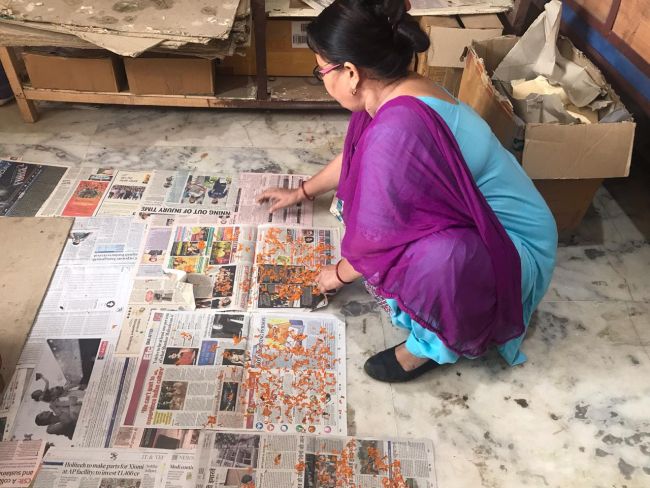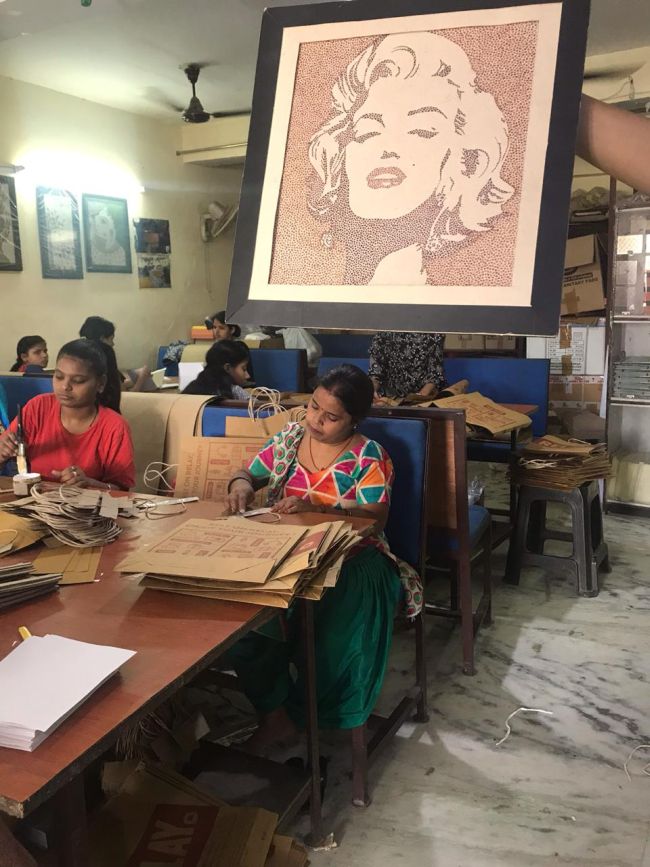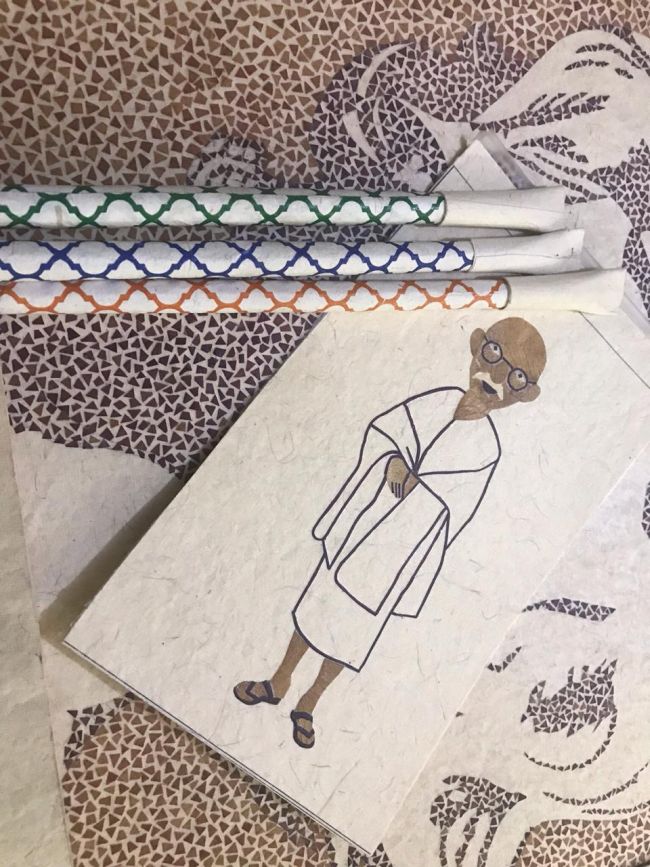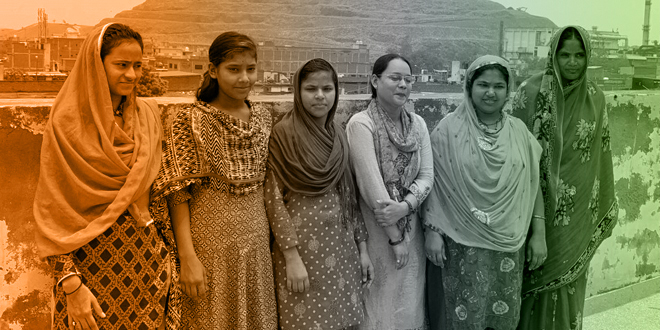New Delhi: It is almost like a contrasting reality to spot – on one hand, there is a big garbage-cum-mountain Ghazipur, which is standing tall at 213 feet, a height equivalent to the size of London’s Tower Bridge and is expected to rise above the height of Taj Mahal (239 feet) in one year’s time. On the other hand, approximately 50 metres away from the dump of Ghazipur, there is a small double storey building where 30 women are doing their bit to overcome the waste mess that has been created by all of us. Welcome to the Delhi-based NGO, Gulmeher Green that creates alternate livelihood opportunities for women waste-pickers of Ghazipur and for women residing in the nearby area.
Approximately 400 families live near the dump, usually sandwiched between the Ghazipur landfill in East Delhi and the city’s largest wholesale meat and flower markets. The people living are largely the migrants from West Bengal, Bihar and Uttar Pradesh, who eke out their living from the thousands tonnes of waste. In 2013, former infrastructure and financial services major IL&FS built a waste-to-energy plant at Ghazipur in a bid to divert waste from the landfill effectively. But the move threatened to leave hundreds of waste-pickers jobless. In a bid to provide alternative livelihoods to the affected communities, the company, through its CSR wing, Nalanda Foundation, kick-started Gulmeher, to make eco-friendly products using the waste materials from the landfill and the flower market of the area.
Explaining how this one small move changed the course of many waste-pickers’ lives at Ghazipur, including 21-year-old Salma, who is originally from Kolkata told NDTV,
Aasman aur zameen ka farq hai zindagi mein, phele din bhar kachre mein rehete the, ab har roz kuch khaas, kuch naya banate hai (There is a huge difference in my life, earlier, I used to spend my entire day at the garbage dump in hope that I will dig out something useful from the waste mountain, now, I utilise the waste and create treasure).
Salma came to New Delhi in search of livelihood and ended up landing at the capital’s largest garbage dump many years ago. Sharing her garbage dump journey, Salma added,
I always dreamt of going to school, making friends and achieving something in my life. But things didn’t go as planned, after my father’s death, I had to come to Delhi in search of livelihood. And by the time I realised what I am doing, I had already made searching waste from Ghazipur my daily ritual. Half of my life just got wasted in dealing with garbage and garbage alone.
Salma’s fate changed in 2013 after the intervention of Gulmeher, today she is no longer labelled as a waste picker, instead, she is called as an ‘Artist’ who is making beautiful eco-friendly, zero-waste products. She has also recently made a poster of the iconic Marilyn Monroe, using waste rose petals. She adds,
I am so glad to be a part of something different. Earlier my routine included waking up and straight away going to the garbage dump. But, now I am making pretty looking products and the irony is that I am still working with waste. From dealing with cardboards to wet waste such as discarded flowers, vegetable waste and paper waste, I deal with it all, only this time I am turning them into creative products.

Every day, Gulmeher Green helps to manage 10 kilos of discarded flower waste and makes beautiful eco-friendly products using it
Along with the poster, Salma is also making other products such as natural holi colours, calendars, gift boxes, diaries, file covers, rakhis, posters to name a few, all using waste items that are available in abundance at Ghazipur or nearby area.
Salma is not alone, 120 women have been trained into skilled artisans, 35 women have been given an alternate livelihood opportunity who earlier were just dependent on Ghazipur, all thanks to Gulmeher Green. Illustrating the journey of transforming waste pickers into artisans, Anurag Kashyap, who started working at Gulmeher as a mentor said,
We started Gulmeher with one motive, to provide the waste-pickers at Ghazipur a new direction of life. Ghazipur is known for its biggest dump site and the flower market; we thought of combining two things and make a sustainable women initiative out of it. This very thought laid the foundation of Gulmeher. As a first step, we tried and motivating the women of Ghazipur on why they need to stop working at the dump site and get involved in something like this. After many trainings and on-ground field visits, we got involved with few of the waste-pickers from Ghazipur and since then we have grown every day, we call it the blessings of waste and flowers.
He further adds,
There were many challenges we faced during our green journey. In 2018, Nalanda Foundation, who started Gulmeher withdraw its support. But a cause like this couldn’t get a full stop and being a mentor I understood that. It was then I decided to step up and take full responsibility for Gulmeher’s fortunes through my NGO Shakti Foundation because a worthy cause like this needs to be taken forward.
Sharing more challenges Gulmeher faced in growing as an eco-friendly organisation, Vidwata Singh who joined the organisation from the starting as a designer adds,
It wasn’t an easy task to convince these women to change their lifestyle. They were happy living the life at the dumpyard and all they cared was about money. They didn’t care much in what ways they are living or what type of working environment they are in, many a times, at the end of the day these women came to us and said, we used to earn more money at the dump, this isn’t helping our lifestyle. Some even left us, but we just continued with our mission – to educate and create alternate livelihood.”
At the starting, Gulmeher used to give the women artisans money based on the work they used to do every day. Within one year, they figured that the model wasn’t working and that’s when they decided to give the women a fixed amount of salary every month. Vidwata Singh adds,
These women had no skills, they had to be taught like nursery kids for the basic things like how to draw a line or how to paste materials etc. So, when at the end of the day these women used to ask us money and we used to see what work they have done and put a value to their work. It was actually nothing, like we couldn’t just pay them Rs 20 only for completing a calendar or some or the other product. That’s when we decided to give all the women artisans a fixed salary of Rs 5500 per month along with a bank account. We made them understand the term money and secure future. Today, these artisans work from 10 to 4, get paid monthly and are allowed to go on leaves as per their choice, every year. When the women started feeling secure, they started staying with us and we grew from one eco-friendly product to another.
A Day At Gulmeher

Today, 120 women have been trained into skilled artisans, 35 Ghazipur women waste-pickers have been given an alternate livelihood opportunity
Every morning, Gulmeher centre in charge, Kamla Joshi goes to the flower market and collect flower waste, approximately 10 kilos of flower waste is collected in a day and then given to other women at the centre who are in charge of drying it in the sun. Meanwhile the designer Vidwata Singh works on the design for the product, once the template is set the women artisans are taught to arrange the waste as per the design and then step by step the product is made. Explaining the working style at Gulmeher, Anurag said,
Vidwata Singh is a dedicated designer who has been trained from National Institute of Fashion Technology, she handles our daily operations and is in charge of designing products and quality checks. She has been giving these women training on how to design eco-friendly products and make use of their skills such as waste segregation and tailoring in an unique way. At Gulmeher, mainly, we deal with flower waste along with other waste items such as cardboard, newspaper, cloth to name a few. Every day, in the morning and evening, one woman is in charge for waste collection whereas some are in charge of drying the flower or vegetable waste in the sun, some are I charge of making boxes if any, while some are in charge of pasting. And together we all make eco-friendly products which are later sold on our official site and other e-commerce sites.

Gulmeher Green women warriors at work – The iconic Marilyn Monroe, captured on canvas with flower petals waste
Apart from the online venture, Gulmeher makes products on order basis which they get from corporate and individual clients. Anurag adds,
Currently, we are growing through word of mouth. Gulmeher organisation is now familiar with our friends and family and as we reach and impact more lives, more and more people are getting aware about us and that is how we are growing. Our online sales are about merely 5 per cent and huge chunk of our sales comes from B2B from corporates. Some of the major clients we have got are Toyota, Maruti and Coke Cola.
From coming out with just one eco-friendly product back in 2013 to selling approximately 46 lakh products last year, Gulmeher, as the organisation has somewhere in the line, made a huge difference and contributed towards a Swachh and cleaner India along with uplifting the lives of many waste pickers from Ghazipur.
Vidwata Singh adds,
We have not just made products that are good for the environment, but over the years have helped shaped lives of the women of Ghazipur. Initially, when I used to come here and see these women I used to feel like they have not even seen mirror and straight away come to work. But over the years I have seen them changing, now they like to dress up, their hair are all tidy and neat, they like to look presentable. So, it is much more than just a green initiative.
Life-Changing Experience For Ghazipur Women
Mukhtaroon shares,
Every day I feel motivated to come here, it feels like a normal job. Currently, I am working on a Ganesha painting using the waste genda flower for the upcoming Diwali season.
28-year-old Rajni says,
It feels like a new life all together. Earlier, I used to spend all my day hunting for something useful from the garbage dump. All I could remember is the bad smell and piles of garbage. This place has given me a new direction and is helping me make beautiful memories.
Describing the monthly money as her treasure, Salma adds,
Today, I have a regular income, it is because of this I have been able to save my life. I was diagnosed with a heart disease earlier, if I was living my life as before in the garbage dump then I wouldn’t have been able to come this long. Now that I am earning a regular amount I have been able to keep up with my medical check-ups. Moreover, I have been able to afford gold and silver items which earlier I could only dream of finding in a garbage dump as my lottery.
What’s In The Making At Gulmeher
With the festival of Rakhi and Independence day around the corner, the women artists at Gulmeher are working towards turning flowers waste into beautiful rakhis along with gift box set that includes a Rakhi, diya, note card and chocolates. For Independence Day, the artisans have made tri-color pens using old newspaper waste and paintings of Mahatma Gandhi.

Independence Day Special: The artisans have made tri-color pens using old newspaper waste and painting of Mahatma Gandhi
The products are priced from a starting range of Rs 25 (for a pen) and it goes up to Rs 5,000 (Paintings or posters). Sharing the difficulty of growing as an eco-friendly organisation, Anurag said,
When we decide a price for our products, we don’t price it for making a certain amount of profit, but to help give women artisans, who were once strangled in the garbage waste, a real life. Being a green organisation, often people assume that the products will be cost effective or cheaper than the usual as they are made using waste. What they don’t understand is the human hours that have gone in delivering that product.
Apart from dealing with waste in a creative way over the years and help give shape to the lives of women of Ghazipur, Gulmeher has also worked towards educating people living around Ghazipur the importance of waste segregation. The organisation previously had tied up with 1000 DDA colony flats with a motto to teach people the importance of waste segregation and de-route waste that ends up straight at Ghazipur landfill. For now, the project has been stopped as the organisation is instutionalising a more formalized plan to manage the waste.
Further mentioning the plans of extending the initiative to dealing with plastic packaging waste and taking the route of green alternatives to packaging, Anurag signed off by saying,
Garbage is like a gold mine, once you start digging it, you will start finding your treasure. If each one of us starts re-routing garbage like we have started doing, I am sure the problem of waste can be managed well, even in the city like ours. Also, there is a dearth of eco-conscious people in our society, once people start accepting waste as something useful, half of the issues our country is facing in terms of waste will be solved.
NDTV – Dettol Banega Swachh India campaign lends support to the Government of India’s Swachh Bharat Mission (SBM). Helmed by Campaign Ambassador Amitabh Bachchan, the campaign aims to spread awareness about hygiene and sanitation, the importance of building toilets and making India open defecation free (ODF) by October 2019, a target set by Prime Minister Narendra Modi, when he launched Swachh Bharat Abhiyan in 2014. Over the years, the campaign has widened its scope to cover issues like air pollution, waste management, plastic ban, manual scavenging and menstrual hygiene. The campaign has also focused extensively on marine pollution, clean Ganga Project and rejuvenation of Yamuna, two of India’s major river bodies.


































